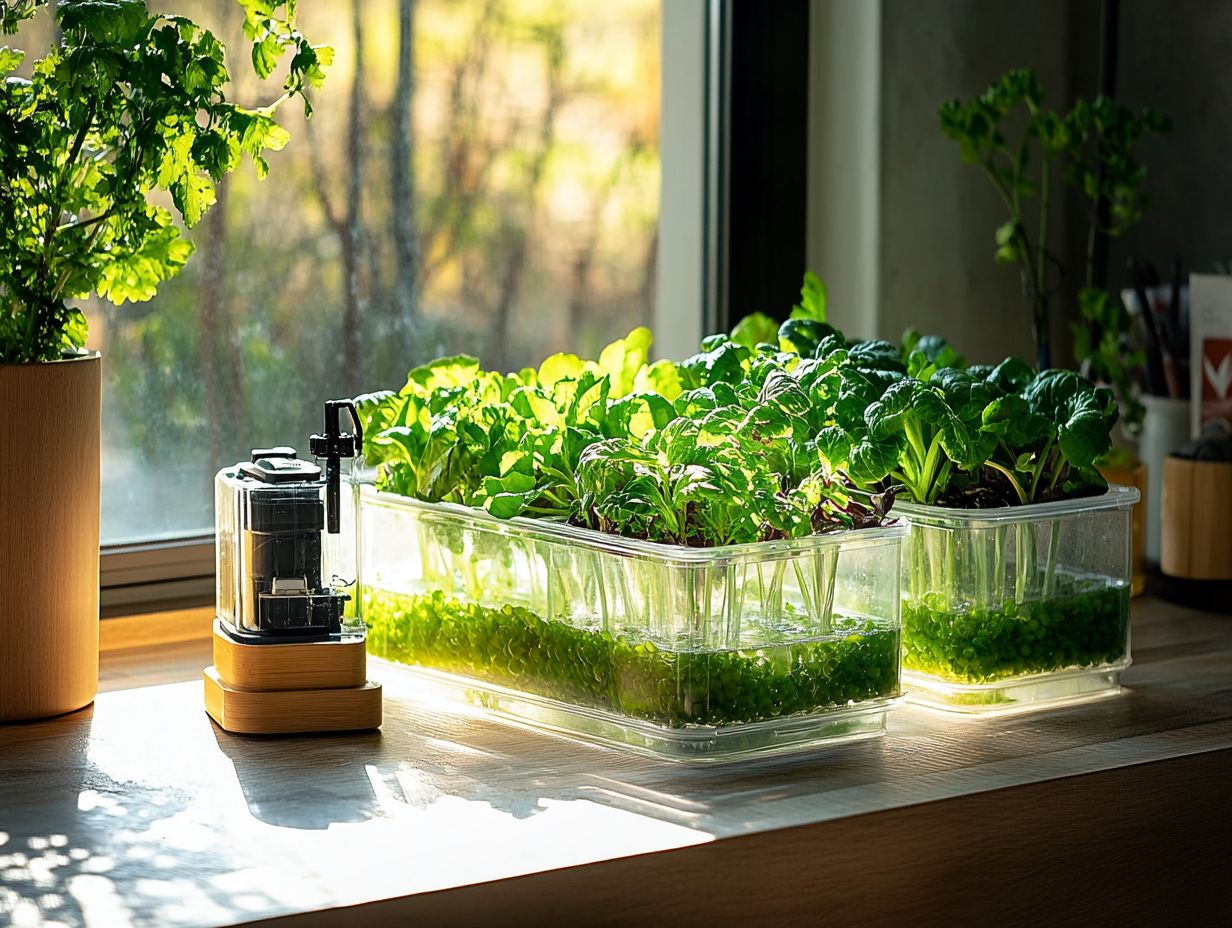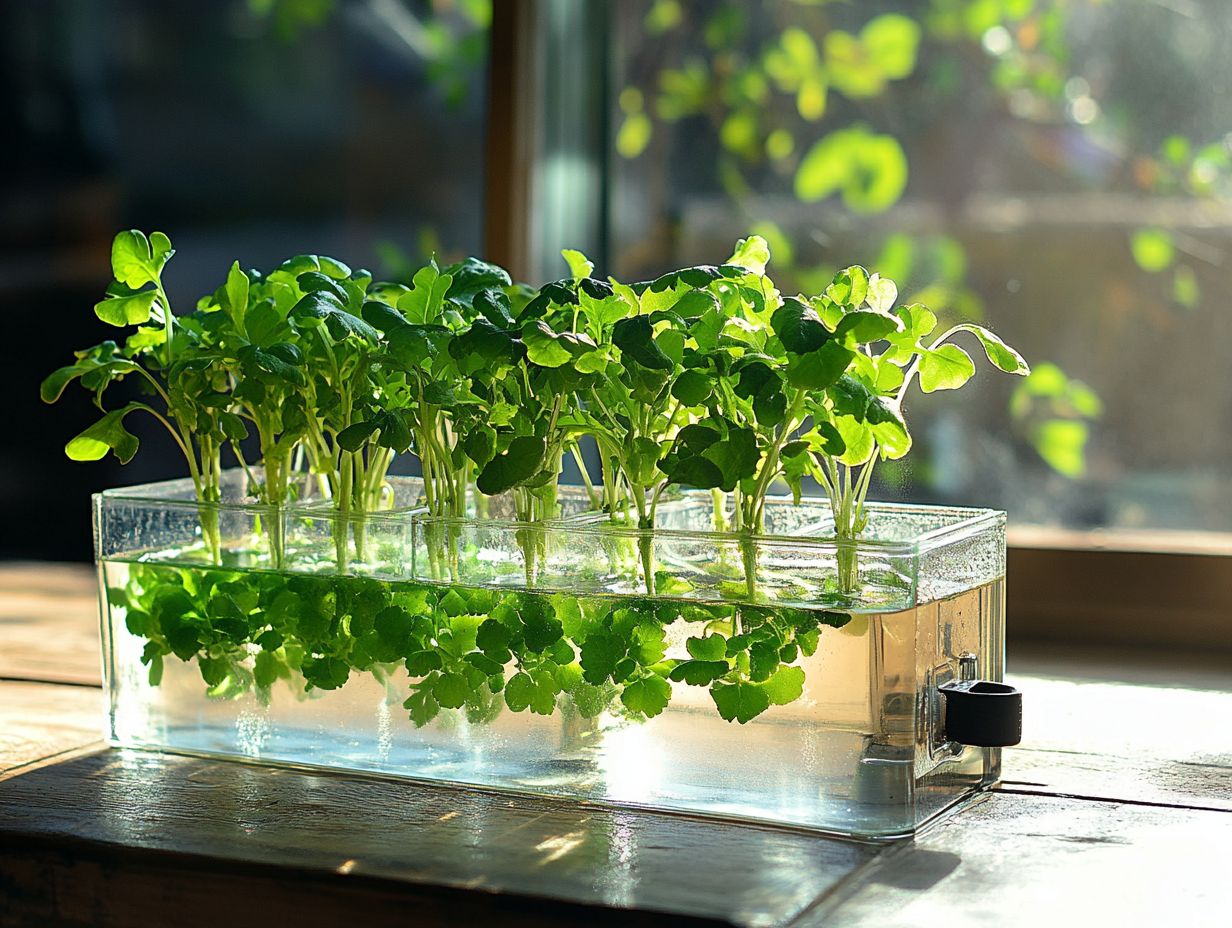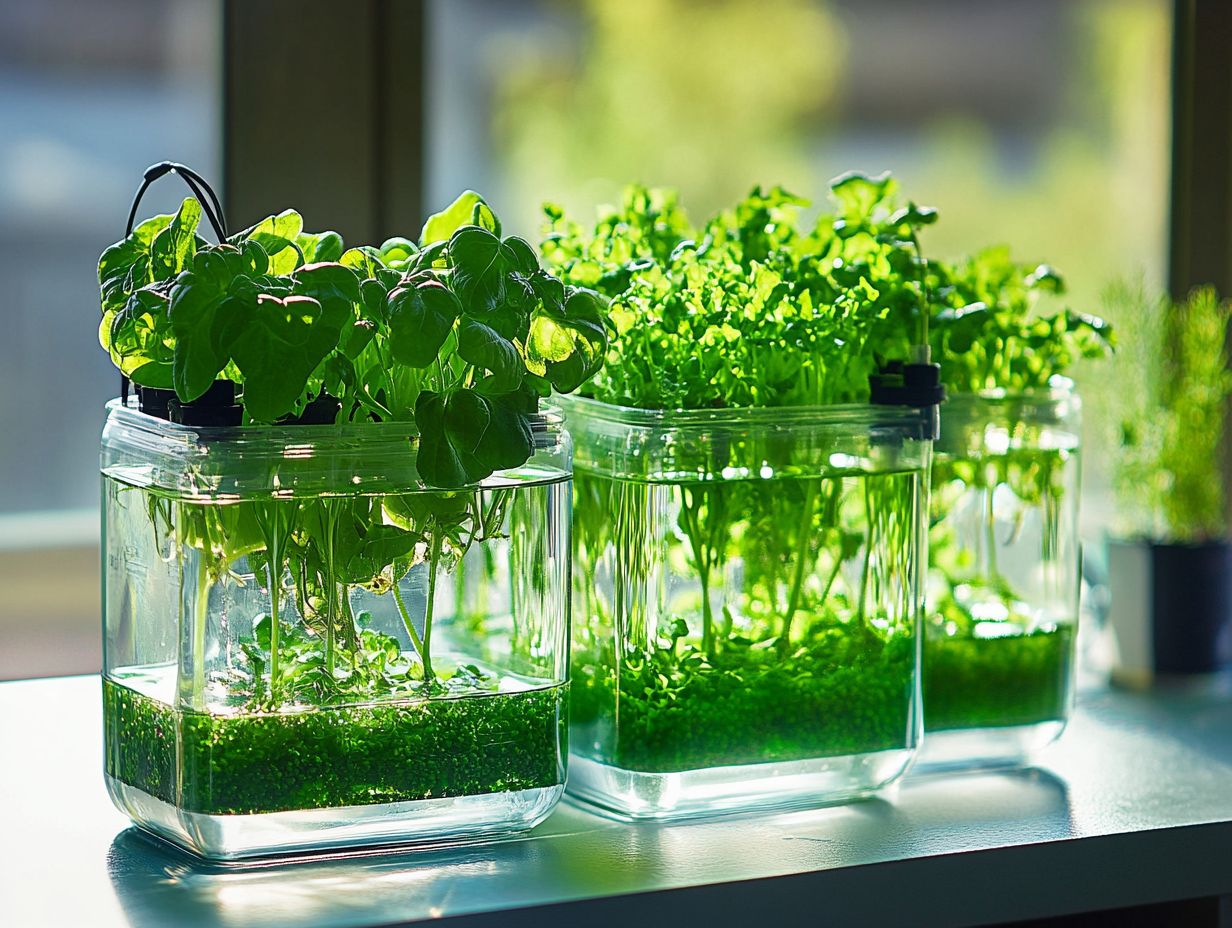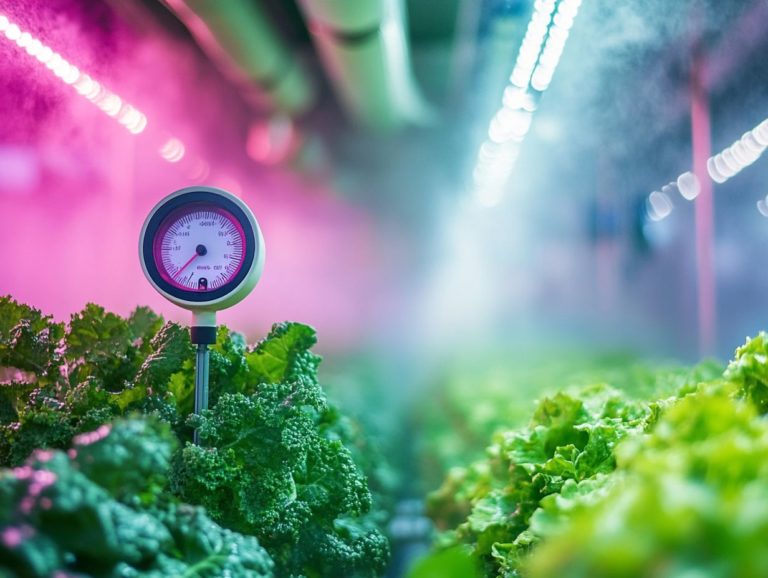A Beginner’s Guide to Hydroponic Systems
Hydroponics is revolutionizing the way you garden. You can now cultivate plants without soil alternatives.
This article explores various hydroponic systems available. From Deep Water Culture to Aeroponics, each offers unique benefits.
You ll discover advantages like enhanced efficiency and the ability to grow fresh crops year-round. A step-by-step guide will help you set up your own hydroponic system easily.
This article also discusses common challenges you might face. Ensure your plants not only survive but thrive!
Contents
Key Takeaways:

- Hydroponic systems use water instead of soil to grow plants, making it an efficient and sustainable method of gardening.
- Beginners can start with simple setups like the wick system or try more advanced options like aeroponics.
- With a clear guide, anyone can easily create their own indoor garden.
What is Hydroponics?
Hydroponics is an innovative agricultural technique that allows you to grow plants without soil. Instead, it uses a balanced mix of nutrients in water.
This method promotes fast plant growth and high crop yields, especially for leafy greens like basil and lettuce. You can use systems like deep water culture and nutrient film techniques.
Dating back to the Hanging Gardens of Babylon, hydroponics has evolved to tackle modern agricultural challenges. By using nutrient-rich solutions, you save space and reduce the risk of pests and diseases.
This approach means you can enjoy fresh crops all year long, offering a sustainable solution to food shortages in urban areas.
The nutrient solutions are vital for photosynthesis. They ensure your plants receive the right minerals and elements to thrive.
Types of Hydroponic Systems
You ll discover a variety of hydroponic systems, each designed to provide nutrients and water in unique ways. These systems offer distinct advantages based on your growing conditions and crop types.
One option is Deep Water Culture, which nurtures roots with oxygen-rich nutrient solutions. Ebb and Flow maximizes water retention while drip systems ensure precise nutrient delivery.
Aeroponics creates optimal air-based growing conditions, while wick systems rely on passive irrigation to support plant health. Each system has its benefits, so choose the one that aligns with your gardening goals.
Start your hydroponic garden today and enjoy fresh produce at your fingertips!
Deep Water Culture
Deep Water Culture (DWC) is a popular hydroponic system that allows you to grow plants with their roots suspended in a nutrient-rich solution. This setup provides optimal access to nutrients, oxygen, and water, promoting healthy growth. DWC is especially effective for fast-growing crops, yielding a remarkable amount of fresh produce in a small space, making it a great choice for indoor gardening or urban farming.
Success in a DWC setup hinges on ensuring roots are submerged in the nutrient solution while receiving enough oxygen. Maintaining oxygen levels in the water is vital to prevent root rot, a disease that affects plant roots, and to help plants absorb nutrients efficiently.
Using air pumps and air stones can effectively oxygenate the water. Regularly checking the nutrient solution’s pH and concentration ensures your plants get the right balance of elements for optimal growth. For those interested in taking their gardening to the next level, learning how to build a simple hydroponic system is beneficial. This system is known for its efficiency, providing faster growth rates than traditional soil methods, making it a favorite among both novice and experienced gardeners.
Ebb and Flow
Ebb and Flow, also called Flood and Drain, is a sophisticated hydroponic system that floods your growing area with a nutrient solution and then drains it away. This process allows roots to absorb essential nutrients while avoiding waterlogging.
Whether you select perlite or clay pellets as your growing mediums, both provide stability and excellent water retention key elements for nurturing thriving plants.
Setting up your Ebb and Flow system requires a few essentials:
- A growing tray
- A reservoir to hold your nutrient solution
- A pump for the flooding action
- A reliable timer to control the flood and drain cycles
Regular maintenance is crucial. Keep an eye on pH levels, change the nutrient solution frequently, and ensure the pump is always in working order.
This system is particularly effective for fast-growing plants like lettuce, herbs, and certain fruiting vegetables. It adapts well to various mediums, making nutrient uptake efficient and effective.
The choice of growing medium significantly impacts root development. Perlite offers excellent aeration, while clay pellets enhance drainage and retain moisture. Together, they create an environment conducive to robust and flourishing plants.
Drip System

The Drip System is an effective hydroponic method that delivers nutrient solutions directly to the base of each plant through a network of tubes and emitters. This approach fosters robust root systems while minimizing water waste. It excels in providing controlled nutrient uptake and is highly customizable for various crops, making it ideal for both small home gardens and larger commercial operations.
With adjustable emitters, you can tailor the water and nutrient supply to match the needs of different plant varieties, ensuring they thrive under optimal growth conditions. The design also includes essential features like filters and pressure regulators, which help maintain a steady flow of nutrient-rich water while preventing clogging.
An efficient drip system boosts hydroponic productivity and significantly reduces the risk of overwatering, enhancing overall plant health and vitality. This method enables you to embrace sustainable gardening practices, contributing to resource conservation while yielding bountiful harvests.
Start your hydroponic journey today and watch your plants thrive!
Aeroponics
Aeroponics is an advanced hydroponic system that elevates plant roots in mid-air, delivering a fine mist of nutrient solution directly to them. This method maximizes oxygen availability and nutrient absorption, allowing for rapid plant growth. You’ll find it particularly useful for high-density planting and capable of yielding top-quality crops while using minimal water. It’s an excellent choice for sustainable living practices.
By employing misting techniques, you can optimize nutrient uptake. The roots enjoy a constant supply of moisture and essential minerals without the limitations of traditional soil cultivation. The aeroponic system not only speeds up plant growth but also dramatically reduces the risk of diseases that often plague soil-grown varieties, thanks to the lower presence of pathogens in the mist.
Since this system operates without soil, you gain the added advantage of controlling pH levels and nutrient concentrations with precision. This ensures your plants receive exactly what they need for optimal health and productivity.
Wick System
The Wick System offers a straightforward, passive hydroponic approach that utilizes wicking action to draw nutrient-rich solutions from a reservoir to your growing medium. This ensures your plants receive a reliable supply of both water and essential nutrients. Enjoy a low-maintenance system that fits perfectly for beginners and is versatile enough to support a variety of crops, making it a cherished option in home gardening and small-scale hydroponics.
The mechanics of this system are refreshingly simple yet remarkably effective, making it accessible for anyone interested in hydroponic methods. You’ll typically need a reservoir filled with the nutrient solution, wicks that extend from this reservoir into the growing medium, and containers to house your plants. For those just starting out, exploring the top 5 hydroponic growing systems for beginners can provide valuable insights. Its passive nature means you won’t have to fuss with constant pumping or aerating, allowing for a truly hands-off experience that is ideal for busy urban gardeners.
The Wick System shines particularly when growing leafy greens, herbs, and some root vegetables. However, choose your materials wisely to ensure thriving plants without delay! Maintaining optimal nutrient solutions is essential for your crops health.
Your choice of growing medium plays a significant role in water retention, so it’s vital to select materials that facilitate both moisture and airflow to the root zone. With the right setup, you’ll be well on your way to enjoying the benefits of this efficient system.
Benefits of Hydroponic Systems
Hydroponic systems have many benefits, particularly when it comes to efficiency and sustainability. They enable you to achieve high crop yields of fresh produce in meticulously controlled growing environments.
By minimizing the necessity for extensive agricultural land and significantly reducing water usage, these systems effectively eliminate soil-borne diseases. This makes hydroponics an especially appealing choice for urban farming and indoor gardening enthusiasts like yourself.
Efficiency and Sustainability
Hydroponic systems are inherently efficient, allowing you to use significantly less water compared to traditional agriculture while offering precise control over nutrient delivery and environmental conditions. This level of sustainability not only conserves precious resources but also reduces the carbon footprint associated with food production, positioning hydroponics as an eco-friendly alternative for modern agriculture.
Take, for example, the stark contrast in water usage: conventional soil farming can require up to 1,800 gallons of water to produce just one pound of tomatoes, whereas hydroponics cuts that down to a mere 20 gallons. It’s a remarkable demonstration of efficiency.
With automated nutrient management systems at your disposal, these systems help you manage the nutrients your plants receive, ensuring optimal growth without the worry of excess runoff that could damage local ecosystems. This controlled environment also reduces the need for pesticides and herbicides, as pests are far less likely to invade these indoor gardens, ultimately leading to healthier produce without compromising the earth’s well-being.
Dive into the world of hydroponics today and transform your gardening experience!
Year-Round Growing

One of the standout advantages of hydroponic systems is the ability to cultivate crops year-round, irrespective of external weather conditions. This makes them exceptionally suited for indoor gardening.
This capability maximizes your crop yield and ensures a consistent supply of fresh produce throughout the year, catering perfectly to the demands of urban farming and local markets.
Year-round cultivation minimizes risks associated with seasonal crop failures, enabling stable production levels and reducing reliance on imported goods.
By harnessing advanced hydroponic technologies such as nutrient film technique, a method where a thin film of nutrient solution flows over the plant roots, and aeroponics, you can optimize nutrient delivery and water usage, enhancing overall resource efficiency.
This sustainable approach bolsters local economies and satisfies increasing consumer demand for fresh, organic produce. Hydroponics is revolutionizing agriculture, and you can be part of this exciting change!
Setting Up a Hydroponic System
Setting up a hydroponic system is an exciting journey that needs some thoughtful planning and the careful selection of materials and equipment to create an optimal growing environment.
You ll need to determine the best hydroponic method for your needs whether it s Deep Water Culture or Ebb and Flow and source high-quality nutrient solutions and growing mediums.
Every step in this process is essential for fostering healthy plant growth.
Materials and Equipment Needed
To successfully establish your hydroponic system, you’ll need a range of materials and equipment, including growing trays, nutrient solutions, and air pumps to ensure proper oxygenation of water and nutrients.
Depending on the hydroponic method you choose, additional components such as light systems and growing mediums like perlite may also be essential for nurturing healthy plant growth.
Each component plays a vital role in creating optimal conditions for your plants.
Growing trays, which can be crafted from various materials to promote drainage, are essential for supporting root development.
Nutrient solutions are specifically designed to deliver essential minerals and vitamins directly to your plants, enabling rapid growth without the need for soil.
Air pumps are crucial for infusing oxygen into the water, preventing root rot and fostering aerobic bacteria that aid in nutrient uptake.
Getting the right balance among these elements can dramatically enhance your yield and overall plant health in your hydroponic setup.
Step-by-Step Guide
Setting up your hydroponic system effectively requires a meticulous approach, guided by a detailed step-by-step plan that covers everything from the initial setup to ongoing maintenance.
Start by selecting the hydroponic method that best suits your goals, whether it’s Nutrient Film Technique (NFT), Deep Water Culture (DWC), or Ebb and Flow systems.
Each choice will significantly impact both the setup and maintenance phases, so choose wisely.
Once you’ve made your selection, gather all the essential components, such as a reservoir, pump, net pots, and growing medium.
With everything in place, you ll need to keep a close eye on key environmental factors light, temperature, and humidity are crucial.
Don t overlook the importance of regularly checking the nutrient levels and pH balance of your solution.
By consistently assessing these elements, you set the stage for your plants to thrive, paving the way for a fruitful harvest.
Troubleshooting Common Issues
Troubleshooting common issues in hydroponic systems is vital for maintaining your plants’ health and securing a successful yield.
Learn about potential problems now to protect your plants and ensure a bountiful harvest!
Familiarizing yourself with issues like nutrient deficiencies, waterborne diseases, and poor growing conditions enables you to take proactive measures.
This way, you can address any plant issues before they escalate, ensuring your garden thrives.
Preventing and Solving Plant Problems

Actively monitor your plants to keep them healthy and thriving! Preventing and addressing plant problems in hydroponic systems requires your attentive monitoring and precise adjustments of nutrient solutions, environmental conditions, and light exposure to help your plants grow better. You can tackle common issues like nutrient deficiencies by routinely testing the nutrient solution and making necessary tweaks to pH levels and nutrient ratios.
In addition to regular checks, try using high-tech tools, such as automated sensors, to significantly boost the efficiency of your hydroponic setup. These sensors provide real-time data on temperature, humidity, and nutrient content, enabling you to respond swiftly to any emerging challenges.
Make a nutrient solution that fits your plants needs. This may involve incorporating essential macro and micronutrients these are the main nutrients plants need to grow well that support healthy development. Regularly changing nutrient solutions and keeping a close watch on root health will also contribute to vigorous growth and help mitigate potential challenges in this growing plants without soil setup.
Frequently Asked Questions
What is a hydroponic system?
A hydroponic system is a method of growing plants without soil, using a nutrient-rich solution to provide the necessary nutrients for plant growth.
What are the benefits of using a hydroponic system?
Hydroponic systems lead to faster growth and higher yields. They also give you better control over plant care. Plus, they use less water and space compared to traditional soil-based gardening.
Do I need special equipment to set up a hydroponic system?
While there are many types of hydroponic systems available, you can start with simple materials such as containers, a water pump, and nutrient solution. More advanced systems may require additional equipment.
What types of plants can be grown in a hydroponic system?
Almost any plant can be grown in a hydroponic system, including herbs, vegetables, fruits, and even flowers. However, some plants may require specific nutrients or environmental conditions to thrive in a hydroponic setup.
Is it difficult to maintain a hydroponic system?
The maintenance of a hydroponic system depends on the type and size of the system. Generally, it requires regular monitoring of the nutrient solution levels, pH, and water quality. However, with proper setup and maintenance, a hydroponic system can be relatively easy to maintain.
Can I save money by using a hydroponic system?
While the initial setup cost may be higher compared to traditional gardening, a hydroponic system can save money in the long run due to its higher yields and more efficient use of resources. Additionally, growing your own produce can reduce grocery expenses.
Start your hydroponic garden today and unlock the secret to fresh, homegrown produce!






